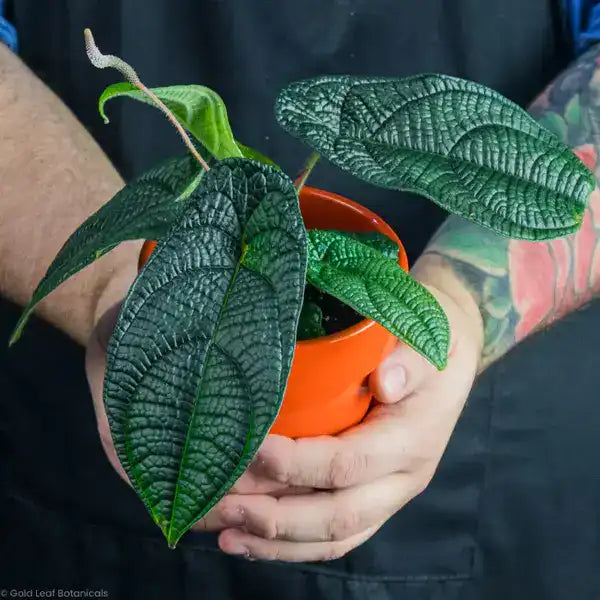
Piper Permatum - Rare
Selling Size : Single Plant | Pot Included | Secure Packing | Free Shipping
Piper parmatum is a rare and unique plant species, often admired for its distinct, textured, and peltate-shaped leaves. Native to the tropical regions of Central and South America, it thrives in specific conditions that mimic its natural habitat. Due to its rarity and specific needs, it is considered a "collector's plant."
Key Care Requirements For Piper Permatum:
Light: Piper parmatum prefers bright, indirect light. Direct sunlight can easily scorch its delicate leaves, while insufficient light can lead to leggy growth and a loss of the plant's unique coloration. An east or north-facing window with filtered light is often ideal.
Water: Maintain consistently moist soil, but avoid overwatering, which can lead to root rot. Allow the top inch of the soil to dry out slightly between waterings. The plant's succulent leaves mean it doesn't need a lot of water. In the winter, when growth slows, you should reduce the watering frequency.
Humidity: High humidity is crucial for this tropical plant. It thrives in an environment with 60-70% humidity. To achieve this, you can place the plant on a tray of moist pebbles, use a room humidifier, or grow it in a terrarium. Avoid misting the leaves directly, as this can encourage fungal issues.
Temperature: This plant prefers warm, stable temperatures, ideally between 18-26°C (64-79°F). Protect it from cold drafts and avoid placing it near heating or cooling vents. Temperatures should not drop below 13°C (55°F) to prevent damage.
Soil: Use a very well-draining, airy potting mix. A mix of leaf mold, humus, and coarse sand or perlite can provide the necessary drainage and nourishment.
Propagation
Piper parmatum can be propagated through stem cuttings, root division, or from seeds. Stem cuttings taken in the spring can be rooted in a warm, humid environment. There have also been reports of successful propagation from leaf cuttings.
Common Issues
Yellowing Leaves: This is often a sign of overwatering, but it can also be a result of too little light. Assess your watering schedule and light conditions to determine the cause.
Pests: Like many houseplants, Piper parmatum can be susceptible to pests such as spider mites and mealybugs. Regular inspection and treatment with insecticidal soap or neem oil can help.
Leaf Drop: Sudden leaf drop in winter can be a sign that the plant is too cold or the air is too dry. Move the plant to a warmer location and increase humidity levels.
Slow Growth: This plant is known for its slow growth, particularly in lower light conditions. While this is natural, ensuring it has enough bright, indirect light will help it produce more leaves. Fertilizing can also be done during the growing season (spring and summer) with a half-strength liquid fertilizer.

